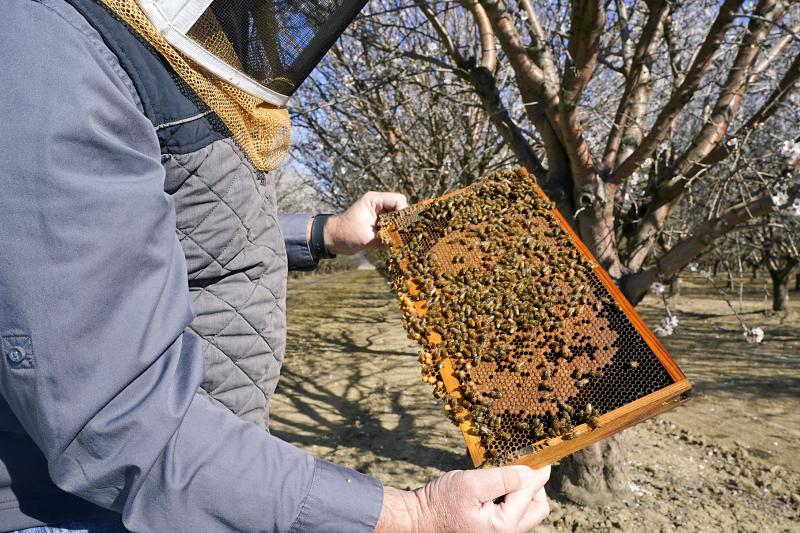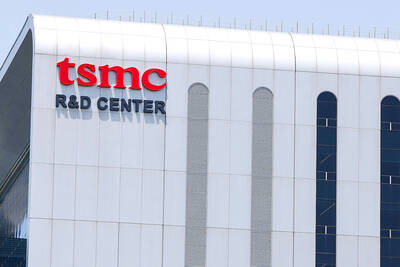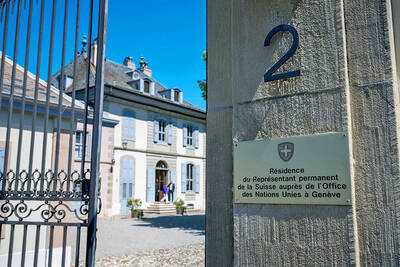For a few frenzied weeks, beekeepers from across the US truck billions of honeybees to California to rent them to almond growers who need the insects to pollinate the state’s most valuable crop.
However, as almond trees start to bloom, blanketing entire valleys in white and pink flowers, so begin beehive thefts, which have become so prevalent that beekeepers are now turning to GPS tracking devices, surveillance cameras and other anti-theft technology to protect their precious colonies.
Hive thefts have been reported elsewhere in the US — recently, three hives containing about 60,000 bees were taken from a grocery chain’s garden in central Pennsylvania — but they happen at a larger scale and uniquely in California at this time of year because bees are most in demand during the largest pollination event in the world.

Photo: AP
In the past few weeks, 1,036 beehives worth hundreds of thousands of dollars were reported stolen from orchards statewide, authorities said.
The largest heist involved 384 beehives that were taken from a field in Mendocino County, prompting the state beekeepers’ association to offer a US$10,000 reward for information leading to their recovery.
“It’s hard to articulate how it feels to care for your hives all year only to have them stolen from you,” Claire Tauzer wrote on Facebook to spread the word about the reward.

Photo: AP
A day later, an anonymous tipster led authorities to recover most of the boxes and a forklift stolen from Tauzer’s family business about 88km away, at a rural property in Yolo County.
One suspect was arrested.
Investigators also found frames, the kinds used to hold honeycombs, belonging to Helio Medina, another beekeeper who lost 282 hives a year ago.
Medina said that the theft devastated his apiary, so this year he placed GPS trackers inside the boxes. He also strapped cable locks around them and installed cameras nearby.
As the almond bloom approached and the hives became most valuable, he drove around patrolling the orchards in the dark.
“We have to do what we can to protect ourselves. Nobody can help us,” Medina said.
Thefts usually happen at night, when no one is in the orchard and the bees are back in their hives. The rustler is usually a beekeeper or someone familiar with the transportation of bees.
“More often than not, they steal to make money and leave the bees to die,” said Rowdy Jay Freeman, a Butte County sheriff’s detective who has been keeping track of hive thefts since 2013.
A tightening supply of bees and soaring pollination fees — jumping from less than US$50 to rent a hive two decades ago to as much as US$230 per hive this year — are likely motivating beekeepers to go rogue.
The demand for bees has steadily risen over the past 20 years as popularity of the healthy, crunchy nut turned California into the world’s biggest almond producer. Accordingly, the amount of land used to grow almonds has more than doubled to an estimated 526,000 hectares.
Beekeepers have been keeping up with that growth by providing an ever-increasing proportion of the nation’s available stock of hives.
This year, a survey of commercial beekeepers estimated that it will take 90 percent of honeybee colonies in the US to pollinate all the almond orchards.
“What that means is that beekeepers are coming from as far as New York and Florida, and to get them to come all that way, pollinator fees have to rise,” said Brittney Goodrich, an agriculture economist at the University of California at Davis.
However, bee populations are notoriously unstable due to a host of problems, including disease, loss of habitat and insecticides. The drought that gripped the western US last summer also weakened colonies. The lack of rain ravaged wildflowers that provide the nectar that bees turn into honey. Beekeepers had to artificially supplement their diet with sugar solutions and pollen substitutes — and incur more costs.
For beekeepers, the loss of a hive means the loss of income from honey production and future pollination, not to mention the expense of managing the hive throughout the year. They say they hardly break even.
“For every [US]$210 paid to rent a beehive, we put close to that much into it the whole year feeding the bees because of drought,” Tauzer said. “We do all the health checks, which is labor intensive, and we pay our workers full benefits.”
Denise Qualls, a pollination broker who connects beekeepers with growers, suspects that the thefts are happening because beekeepers cannot provide the strong colonies they promised, “so they can get the money from the grower and then they leave the hives.”
“The grower is just as responsible when they accept them,” she said.
To help her clients track their investments, Qualls merged her business with tech start-up Bee Hero to equip hive boxes with a GPS-enabled sensor.
Freeman, who got into beekeeping after investigating his first hive theft, said he advises beekeepers to use security cameras, and put their names and phone numbers on the boxes.
Some beekeepers have tried tagging their boxes with SmartWater CSI, a forensic tool used to help police trace recovered stolen property, he said.
The clear liquid is visible only under UV light, even through layers of paint, so police can ascertain the rightful owner even when thieves try to disguise boxes.
To raise the crime’s severity, Freeman worked with prosecutors in 2016 to charge a man accused of stealing 64 beehives with theft of livestock.
Under California law, theft of property worth US$950 or less is classified as a misdemeanor, but the theft of any agricultural product worth at least US$250 is considered a felony.
“Stealing one or 10 or 100 hives would result in the same charge,” he said.
The man pleaded guilty and was sentenced to 90 days in jail and three years probation.
The California State Beekeepers’ Association urges beekeepers to communicate regularly with growers about where their hives are placed, and encourages growers to hire reputable beekeepers who can show proof of ownership of their hives.
Meanwhile, the almond industry is trying to reduce its dependence on bees by growing “self fertile” almond varieties that require fewer bees for pollination, and by investing in research and other initiatives aimed at improving their health.
The Almond Board of California also joined a coalition of agricultural, environmental and government groups to create habitat for wild bees, butterflies and other pollinators on privately owned working land such as cattle ranches and orchards.
The state government is funding US$15 million toward the effort, calling it an investment in “climate smart agriculture.”

BIG BUCKS: Chairman Wei is expected to receive NT$34.12 million on a proposed NT$5 cash dividend plan, while the National Development Fund would get NT$8.27 billion Taiwan Semiconductor Manufacturing Co (TSMC, 台積電), the world’s largest contract chipmaker, yesterday announced that its board of directors approved US$15.25 billion in capital appropriations for long-term expansion to meet growing demand. The funds are to be used for installing advanced technology and packaging capacity, expanding mature and specialty technology, and constructing fabs with facility systems, TSMC said in a statement. The board also approved a proposal to distribute a NT$5 cash dividend per share, based on first-quarter earnings per share of NT$13.94, it said. That surpasses the NT$4.50 dividend for the fourth quarter of last year. TSMC has said that while it is eager

‘IMMENSE SWAY’: The top 50 companies, based on market cap, shape everything from technology to consumer trends, advisory firm Visual Capitalist said Taiwan Semiconductor Manufacturing Co (TSMC, 台積電) was ranked the 10th-most valuable company globally this year, market information advisory firm Visual Capitalist said. TSMC sat on a market cap of about US$915 billion as of Monday last week, making it the 10th-most valuable company in the world and No. 1 in Asia, the publisher said in its “50 Most Valuable Companies in the World” list. Visual Capitalist described TSMC as the world’s largest dedicated semiconductor foundry operator that rolls out chips for major tech names such as US consumer electronics brand Apple Inc, and artificial intelligence (AI) chip designers Nvidia Corp and Advanced

Saudi Arabian Oil Co (Aramco), the Saudi state-owned oil giant, yesterday posted first-quarter profits of US$26 billion, down 4.6 percent from the prior year as falling global oil prices undermine the kingdom’s multitrillion-dollar development plans. Aramco had revenues of US$108.1 billion over the quarter, the company reported in a filing on Riyadh’s Tadawul stock exchange. The company saw US$107.2 billion in revenues and profits of US$27.2 billion for the same period last year. Saudi Arabia has promised to invest US$600 billion in the US over the course of US President Donald Trump’s second term. Trump, who is set to touch

SKEPTICAL: An economist said it is possible US and Chinese officials would walk away from the meeting saying talks were productive, without reducing tariffs at all US President Donald Trump hailed a “total reset” in US-China trade relations, ahead of a second day of talks yesterday between top officials from Washington and Beijing aimed at de-escalating trade tensions sparked by his aggressive tariff rollout. In a Truth Social post early yesterday, Trump praised the “very good” discussions and deemed them “a total reset negotiated in a friendly, but constructive, manner.” The second day of closed-door meetings between US Secretary of the Treasury Scott Bessent, US Trade Representative Jamieson Greer and Chinese Vice Premier He Lifeng (何立峰) were due to restart yesterday morning, said a person familiar